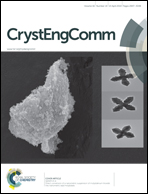Ti thin film towards the growth of crystalline-TiO2 nanostructures: stepped light-induced transient measurements of photocurrent and photovoltage in dye sensitized solar cell
Abstract
Highly dense and well-defined TiO2 nanoflowers (NFs) were grown by the hydrothermal process on a titanium (Ti) coated FTO substrate. The Ti layer with a thickness of ~500–600 nm was deposited on FTO at room temperature with a pressure of ~5 mTorr using a Ti-source through RF magnetic sputtering. The unique TiO2 NF thin film substrate was applied as a photoanode for the fabrication of a dye sensitized solar cell (DSSCs). Each NF was made of uniform clover leaf-like petals of an average diameter of ~80–100 nm. The synthesized TiO2 NFs possessed a pure anatase phase with good crystal quality. The fabricated DSSC with TiO2 NF thin film photoanode accomplished a reasonably good overall solar-to-electricity conversion efficiency (η) of ~3.64% with a high short circuit photocurrent density (JSC) of ~9.6 mA cm−2. The improved performance and photocurrent density were explained by the charge transport time, diffusion coefficient, diffusion length and charge collection efficiency of the fabricated DSSC.


 Please wait while we load your content...
Please wait while we load your content...